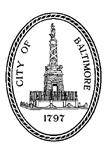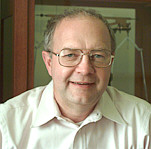



November Historical Events in Spectroscopy by Leopold May, Catholic University
 December
Historical Events in Spectroscopy by Leopold May, Catholic University
December
Historical Events in Spectroscopy by Leopold May, Catholic University
Speaker: Dr. Edgar Etz, Analytical Microscopy Research Group, National Institute of Standards and Technology
Location: Ristorante Tartufo, 9021 Gaither Road (at the intersection of Shady Grove Road and Gaither Road), Gaithersburg, MD 20877
Highlights from the November SAS Meeting
Dr. Suenram gave a fascinating talk describing the evolution of FTMW spectroscopy and detailing many recent applications, including the characterization of chemical warefare agents. Below are a few photographs from the meeting.
November Meeting Notice - Thursday, November 4, 1999 (Downloadable meeting notice PDF here)
Fourier Transform Microwave Spectroscopy: Historical Perspectives and the Evolution Toward an Analytical Technique.
In 1981 the late Willis H. Flygare and his group of graduate students and post doctoral associates developed a new microwave spectroscopic technique that revitalized the field of rotational spectroscopy. The new technique involved the used of a tunable Fabry-Perot microwave cavity in conjunction with a pulsed molecular beam valve and pulsed microwave radiation. The technique has evolved into what is now known as Fourier Transform Microwave (FTMW) spectroscopy. As it was initially introduced, it proved to be a powerful technique for studying the rotational spectra of hydrogen bonded dimers and van der Waals complexes. This trend continued throughout the 1980's as more and more research laboratories around the world constructed this type of instrument. It is estimated that today there are approximately 30 laboratories that have one or more of these instruments in use. The first NIST instrument was constructed in 1985 and was used to study a number of van der Waals complexes as well as hydrogen bonded dimers and trimers. More recently the emphasis at NIST has shifted toward the analysis and characterization of larger organic monomers with molecular weights in the 100 to 200 amu range. The 1K temperature of the molecular beam greatly simplifies the spectra of these compounds and permits their analysis. Over time, many changes have been made in the instrument resulting in dramatic improvements in overall sensitivity of the technique as well as greatly improved ease of use. In the early 1990's it became clear that this technique could offer some advantages to the analytical chemistry community as a new spectroscopic technique for trace gas analysis. Several laboratories have begun to address this issue. In the presentation, general historical perspectives will be given, in addition to describing details of the development of an analytical prototype FTMW spectrometer at NIST.
 Dr.
Richard Suenram is the Group Leader of the Spectroscopic
Applications Group, Optical Technology Division, Physics Laboratory at NIST
where he has worked since 1975. He has received the Bronze Medal Award from
the US Department of Commerce for his contributions to the spectroscopic sciences.
Prior to joining NIST, Dr. Suenram was employed in industry by Rohm and Haas.
He has a Ph.D. and MS in Physical Chemistry, from the University of Kansas (Lawrence)
and the University of Wisconsin (Madison), respectively. His research interests
are in the areas of hydrogen-bonded and van der Waals complexes, atmospheric
molecules, reaction mechanisms, and conformational equilibria of large organic
compounds using Fourier Transform microwave (FTMW) spectroscopic techniques.
He has also extensively used FTMW spectroscopy for trace gas analysis. Currently,
Dr. Suenram is developing new terahertz instrumentation and methods for studying
ro-vibrational spectra of molecules in this region.
Dr.
Richard Suenram is the Group Leader of the Spectroscopic
Applications Group, Optical Technology Division, Physics Laboratory at NIST
where he has worked since 1975. He has received the Bronze Medal Award from
the US Department of Commerce for his contributions to the spectroscopic sciences.
Prior to joining NIST, Dr. Suenram was employed in industry by Rohm and Haas.
He has a Ph.D. and MS in Physical Chemistry, from the University of Kansas (Lawrence)
and the University of Wisconsin (Madison), respectively. His research interests
are in the areas of hydrogen-bonded and van der Waals complexes, atmospheric
molecules, reaction mechanisms, and conformational equilibria of large organic
compounds using Fourier Transform microwave (FTMW) spectroscopic techniques.
He has also extensively used FTMW spectroscopy for trace gas analysis. Currently,
Dr. Suenram is developing new terahertz instrumentation and methods for studying
ro-vibrational spectra of molecules in this region.
Your Baltimore-Washington Section Officers for 1999-2000:
![]()
Visit our local section sponsor WWW pages:
Spectral Dimensions, Inc. designs and manufactures chemical imaging instrumentation. It is a privately owned company with its principal office located in Olney, MD. The company was formed in response to an increasing demand for new and more powerful spectroscopic imaging technologies. Its product line encompasses systems for performing FT-IR, NIR, and Raman imaging in a variety of basic research and process control applications.
The Perkin-Elmer Corporation - Analytical Instruments Division. Take a look and you will see more: The AA ANALYST systems have set a new standard for flame and furnace users, utilizing true STPF conditions and total automation. The State of the Art OPTIMA 3000 series systems having sold nearly 2000 units in less than four years, has become a staple for ICP-OES users. With simultaneous and sequential versatility, increased speed and the widest dynamic range for ICP. The industry leader ELAN 6000 ICP-MS system which is installed in more than 50% of all environmental laboratories using ICP-MS worldwide has continued to be a stellar performer.
 Gascoyne Laboratories, a privately-owned and operated
independent testing laboratory for environmental analyses. Now in its 113th
year of continuous service. Contact info: 2101 Van Deman Street, Baltimore,
MD 21224-6697, 1-800-GASCOYNE, (410) 633-1800, Fax (410) 633-6553
Gascoyne Laboratories, a privately-owned and operated
independent testing laboratory for environmental analyses. Now in its 113th
year of continuous service. Contact info: 2101 Van Deman Street, Baltimore,
MD 21224-6697, 1-800-GASCOYNE, (410) 633-1800, Fax (410) 633-6553
 Nicolet Intrument Corporation, US Eastern Regional Sales,
9901 Business Parkway, Suite H, Lanham, MD 20706 (800) 237-2800, FAX: (301)
731-5761. Nicolet is the industry leader in Fourier transform infrared (FT-IR)
and Fourier transform Raman (FT-Raman) spectroscopy products. The most complete
source for Research FT-IR instrumentation, IR microspectroscopy, FT-Raman
spectrometer systems, high-resolution spectral databases, sampling accessories
and experiments, and spectroscopy software.
Nicolet Intrument Corporation, US Eastern Regional Sales,
9901 Business Parkway, Suite H, Lanham, MD 20706 (800) 237-2800, FAX: (301)
731-5761. Nicolet is the industry leader in Fourier transform infrared (FT-IR)
and Fourier transform Raman (FT-Raman) spectroscopy products. The most complete
source for Research FT-IR instrumentation, IR microspectroscopy, FT-Raman
spectrometer systems, high-resolution spectral databases, sampling accessories
and experiments, and spectroscopy software.
Your Local Nicolet Representatives
Mike Pannella- Technical Sales
Larry Ottolini - Technical Service
Wayne Fowler - Technical Service
Dr. Joe Schoppelrei - Application Scientist
Chris Rodriguez - Application Scientist
![]()
Past Issues of the Baltimore-Washington Section Newsletter (including Historical Events in Chemistry for those months)
 Go to the National SAS Home Page
Go to the National SAS Home Page